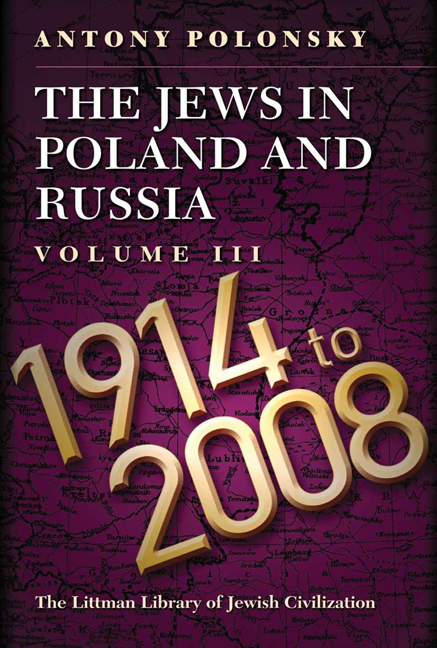Book contents
- Frontmatter
- Dedication
- Acknowledgements
- Contents
- List of Maps
- List of Tables
- Note on Transliteration
- Note on Place Names
- Maps
- General Introduction
- PART I FROM THE FIRST WORLD WAR TO THE SECOND
- PART II WAR AND GENOCIDE, 1939–1944
- PART III FROM THE END OF THE SECOND WORLD WAR TO THE COLLAPSE OF THE COMMUNIST SYSTEM
- EPILOGUE JEWS IN EASTERN EUROPE AND RUSSIA SINCE THE END OF COMMUNISM
- Conclusion
- Glossary
- Bibliography
- Index
3 - Jewish Life in the Towns and Cities of Inter-War Poland
- Frontmatter
- Dedication
- Acknowledgements
- Contents
- List of Maps
- List of Tables
- Note on Transliteration
- Note on Place Names
- Maps
- General Introduction
- PART I FROM THE FIRST WORLD WAR TO THE SECOND
- PART II WAR AND GENOCIDE, 1939–1944
- PART III FROM THE END OF THE SECOND WORLD WAR TO THE COLLAPSE OF THE COMMUNIST SYSTEM
- EPILOGUE JEWS IN EASTERN EUROPE AND RUSSIA SINCE THE END OF COMMUNISM
- Conclusion
- Glossary
- Bibliography
- Index
Summary
Warsaw, dear city of mine, how sad I am! Already before I have left you, I long for you. I look at your crooked roofs, your factory chimneys, your thickly-crowded skies, and I realize how deeply rooted you are in my heart. I know it will be good to live in a strange country, but when the time comes to die, I want to lie in the cemetery on Gęsia, near my beloved grandmother.
Hadassah, in ISAAC BASHEVIS SINGER, The Family MoskatWe gather like the chestnuts on the Planty of Krakow.
We thread a chain of memory longer than slavery;
Our idyllic Kraków Jewish childhood,
Days of struggle and exaltation, days of youth and pranks,
Days of love, days of happiness, days of disaster, days of sadness.
Who knows as well as you, you Kraków streets,
What once pained us, what still pains us—
Our Jewish fate?
NATAN GROSS, ‘Kraków Autumn’BY THE INTER-WAR PERIOD there had been a substantial movement on the part of the Jewish population of Poland from the shtetls and the countryside to the larger towns. According to the 1931 census, 43.3 per cent of Jews lived in towns with a population of more than 20,000, where they made up 26.4 per cent of the total population. The six largest Jewish conurbations were Warsaw, łódź, Lviv, Kraków, Vilna, and Białystok. Other sizeable conurbations were Lublin, Czeęstochowa, and Sosnowiec. Table 3.1 shows the populations of the twelve largest Polish towns, the size of the Jewish communities, and Jews as a percentage of the whole.
Yet a substantial proportion of the Jewish population (29.8 per cent) still lived in towns with a population of less than 20,000—the traditional shtetls—where they made up 28.8 per cent of the population, while 23.1 per cent lived in villages and in the country, where they made up 3.2 per cent of the population. Thus, the majority of the Jewish population still lived in the largely pre-modern world of the Polish countryside and its market towns. This chapter will examine these very different locations of Jewish life.
JEWS IN THE LARGER POLISH TOWNS AND CITIES
Polish towns and cities developed rapidly in the inter-war period. This was particularly true of Warsaw, the capital of the new state.
- Type
- Chapter
- Information
- The Jews in Poland and RussiaVolume III: 1914 to 2008, pp. 98 - 149Publisher: Liverpool University PressPrint publication year: 2012

